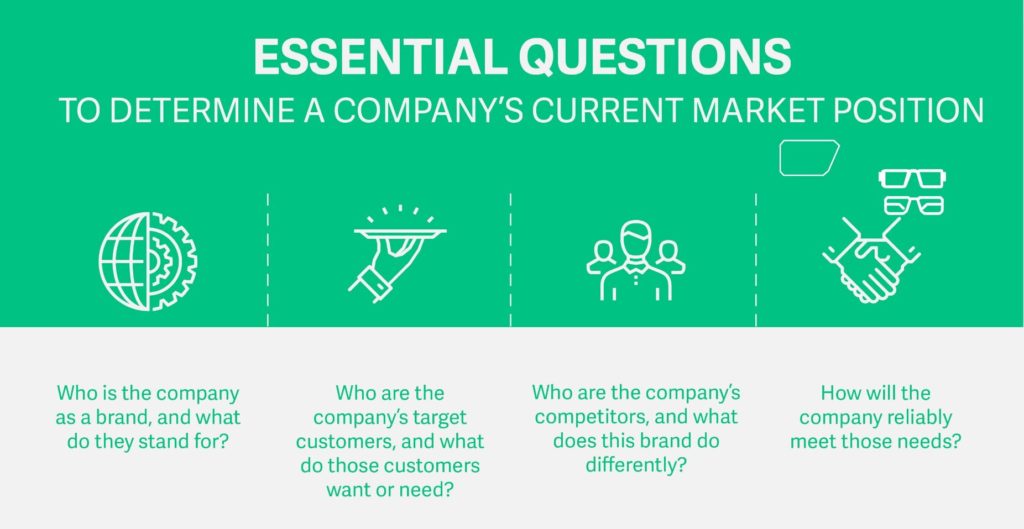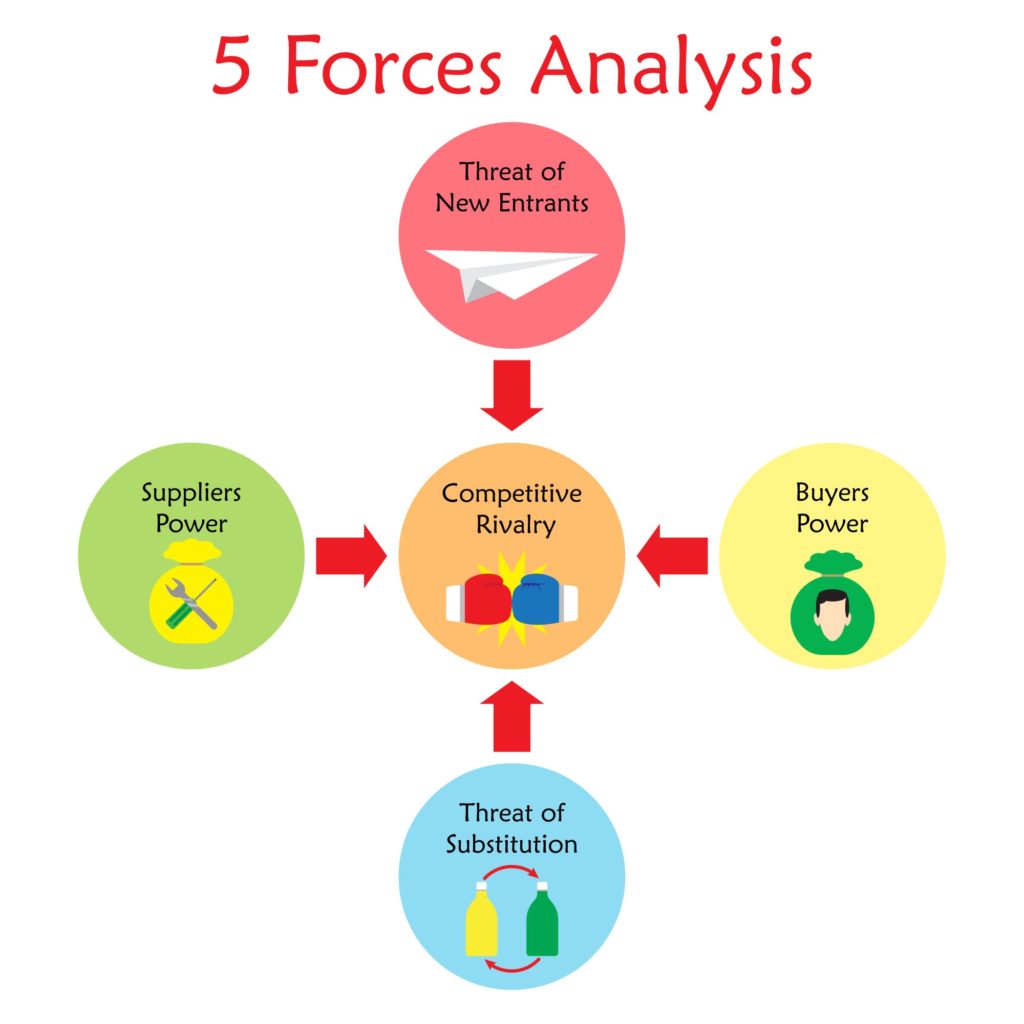
According to Yankelovich, a market research firm, people receive an average of 5,000 brand messages a day. Other experts greatly disagree on this number. But one can infer what the point is: we live in a time where there’s an information overload. This has shortened our attention span that it’s become comparable to a goldfish. That means, to a marketer, our attention is more precious than ever.
There’s a sea of information clutter. Brands are using a multitude of marketing strategies just to get a few seconds of your time.
But not all of them succeed. In fact, many of them fail.
Why? Because of their brand positioning.
Therefore, before you enter the market, it’s imperative that you come up with a good brand positioning strategy. Otherwise, your messaging will get lost in a sea of information clutter.
What is a brand positioning strategy?
Brand positioning allows you to understand the hearts of the consumers. How? By collecting and analyzing market data to draw the similarities and differences between you and your competitors. More importantly, it’s understanding your target market on a deeper level.
Based on your research, you’ll be able to establish your brand’s identity that customers will relate to. Moreover, if you execute a good brand positioning strategy, you’ll stand out from the competition. That includes getting more customers aware of your brand and building a long-term relationship with them.
The importance of brand positioning
Brand positioning helps you define your brand and understand your core proposition. This enables you to strategize how your brand should communicate with your customers, as well as which marketing channels you should focus on.
It also amplifies your messaging. This is especially important if you want to cut through the noise and compete on value. If you can do this, you’ll be able to justify your pricing against your competitors, and it will also lead to more people buying from you.
7 steps to brand positioning
Effective brand positioning can be divided into 7 steps. If you can follow these steps to the T, you’ll significantly lessen the degree of competition you have in the market.
1. Draft a positioning statement
If you ignore your brand positioning, it can lead to your target audience misunderstanding what you have to offer. If they misunderstand you, it’s most likely because you might not know yourself as a brand.
To avoid this situation, you must answer the following questions accurately. This will help you think about your positioning statement:
Who are you as a brand?
The unique aspect of your brand or product will help you win against your competitors. However, establishing this uniqueness shouldn’t rely on positioning alone. Specify the product features and benefits that only your brand can provide to potential customers. If these features and benefits are missing in the market, then it makes your brand more appealing.
Who is your main target audience and what do they want or need?
Once you’ve determined the uniqueness of your brand, you can then think about your customers’ profile. These customers will be your primary guide in positioning.
How can you reliably meet their needs?
Regardless of the size of the brand or the company, know that you can’t always please everyone.
Therefore, you need clear market segmentation. This will help you serve your market in a more meaningful way. How? By focusing on their wants, needs, and values. The more targeted the message is, the more they’ll resonate with it because “it’s not just another ad”.
Who are your competitors and how do you differ from them?
If you’re new to the market, you must make a lot of effort to keep up with the competition!
Also, it’s not a good idea to make yourself look like other brands.
You may feel like you’re paying tribute to your competitors by imitating them, but this is not a good strategy. Or you may think that you’ll also make a lot of money if you copy them, but get this…
If there are too many competitors offering products that look the same (and you, being one of them), it’ll likely weaken your brand. The best way is to come up with something unique about your product/brand. Make it different. Find your USP (Unique Selling Proposition) and stand out from the crowd.
2. Compare and contrast to identify your own uniqueness
Identify your communication strategy and see how it holds up against your competitors. Check their marketing channels and then look for market gaps. This will help you identify the best market position for your brand.
Try to answer these questions, as your answers will become your reference for the next steps.
 3. Competitor analysis
3. Competitor analysis
Analyzing your competitors can help you understand your own strengths and weaknesses. This will lead you to the market’s gaps.
At this stage, you must conduct a thorough analysis to understand what your competitors have. Like the strategies they use, actions they’ve implemented since entering the market, and possible plans for the future. Getting these things will help you optimize your own strategy. You will have a good idea on what used to work, what’s currently working, and what’s likely to work in the future. And the more thorough your analysis is, the more advantage you’ll have in the market.
With regards to your research and analysis phase, some information might be easy to find. Others might require time and effort. Though you might find it challenging to constantly update your data, this will help you develop your own marketing strategy, assist in your brand positioning, and find unmet needs (gaps) in your market.
Your detailed competitor analysis can be broken down into the following 4 steps:
(1) Competitor’s goal: This may not be a financial goal, but may be market share or growth rate. If you can point out one or two important indicators, such as short-term revenue or investment in research content, software development, and international markets, then you can speculate the goals of your competitors and take corresponding actions.
(2) Competitor’s assumptions: Find out your competitor’s past experiences, market trends, and other factors such as culture. You should regard them as reference values for other data.
(3) Competitor’s strategy: This may be the most difficult information to find. But it’s the most useful data. Look at press releases, white papers, shareholder reports, promotions, company mergers, acquisitions, and recruitment to know your competitor’s next moves.
(4) Competitor’s ability: After you answer the 3 questions above, you can now create an outline of your competitor’s ability. This will tell you their strengths and weaknesses and help you determine which area you should focus on.
Where can you find your competitor’s information?
-
- Their website
- Official/Fan pages on social media platforms (Facebook, Instagram, Twitter, YouTube, LinkedIn, etc.)
- Forums
- News media
- Pay-per-click ads
- Reviews of their products
4. Confirm your current brand positioning
Confirming your current brand positioning is as important as analyzing your competitors. Why? Because when you understand where your you, you will know what your current market share is. It’ll give you an idea regarding what your potential customers think about you. Whether they think your pricing is high, or your product is practical and in demand, etc.
This answers the question, “What kind of brand is it?” as compared to other competing brands.
 5. Competitor positioning analysis
5. Competitor positioning analysis
Competitor positioning analysis allows you to confirm how much influence your competitors have on the market.
Michael Porter proposed that there are 5 “forces” in the analysis of your competitors’ positioning. These forces affect the profit potential of the industry you’re in.
 Threat of New Entrants: What is the profit of the market? The higher the profit of the market, the easier it is to attract new sellers to enter the market. This will cause a situation where market profits are divided, making the existing market threatened. If the market entry barriers are very high, they reduce the threat of new entrants. Conversely, if the barriers are low, expect new players to come in.
Threat of New Entrants: What is the profit of the market? The higher the profit of the market, the easier it is to attract new sellers to enter the market. This will cause a situation where market profits are divided, making the existing market threatened. If the market entry barriers are very high, they reduce the threat of new entrants. Conversely, if the barriers are low, expect new players to come in.
Threat of Substitution: How many similar products are currently on the market? When there are more similar products, the brand can easily become price-oriented. A substitute product uses a different technology to solve the same economic need. For example, plant-based milk is becoming more popular than regular milk. They’re selling the customers the idea of “cruelty-free” products, as well as plant-based milk being more healthy than cow’s milk.
Buyers’ Bargaining Power: The buyers’ ability to place pressure on the sellers regarding price changes. Buyers who meet the following conditions will have greater bargaining power:
-
- The total number of buyers is small, but the purchase volume is large, accounting for a large proportion of the seller’s sales
- The seller’s industry consists of a large number of relatively small companies
- The product purchased by the buyer is basically a standardized product, which can be purchased from multiple sellers at the same time
- Buyers have the ability to achieve backward integration, but sellers cannot integrate forward
Suppliers’ Bargaining Power: The number of suppliers can be the source bargaining power, especially when there’s high demand and low supply. Suppliers who meet the following conditions will have greater bargaining power:
-
- Have a relatively stable market position and not be controlled by companies that are troubled by fierce market competition. There are many buyers of products, so every single buyer will not become the supplier’s most important customer
- The products of the supplier have their own characteristics, so it’s difficult for the buyer to switch or the switching cost is too high, and it is difficult to find a competitive substitute
- The supplier has the ability to extend the industry chain vertically
Competitive Rivalry: How many competitors currently exist in the market? When more competitors offer similar products or services, the attractiveness of the market decreases. The following situations may intensify competition among enterprises:
-
- Low barriers to entry in the industry and many evenly matched competitors
- The market is maturing, and the demand for products is growing slowly
- Competitors use price reduction and other means to promote
- Competition can provide almost the same products or services, making conversion costs very low
Competitor analysis will help you understand the factors that affect market profits. The result will also help you evaluate whether you want to enter the industry or increase the scale of the existing industry, and how to develop your competitive strategy.
At this stage, you have to compare the information you got from competitor analysis and competitor positioning analysis.
6. Develop a unique positioning idea
When you determine your ideal brand positioning, your next goal is to create a unique impression in the minds of the buyers. Hopefully, it’s something that won’t trigger this impression:
“Oh, it’s just another copycat. I’ll try it as an alternative if I can’t get my hands on this more popular brand.”
Anyway… at this point, you should be able to clearly point out:
- Your company’s values
- The current problems in your market
- The solution(s) to these problems
- Your process on how you can communicate with your customers
- The benefits you’ll provide to your customers
Knowing these things will help you adjust your overall strategy. For example, do you need to add multiple languages to your website to meet different market needs? Do you need to change your selling options from just bulk orders to also offering single item purchases? Will offering a free product attract more customers?
Getting clear on your strategy will save you time and minimize your losses.
(To begin with, you don’t want to enter the market, only do trial-and-error, and then adjust accordingly. It’s more likely that you’ll make mistakes than hit them correctly right from the start. If you can minimize your mistakes, then you can minimize your costs. So plan your positioning first!)
How to write your branding positioning statement
Your brand positioning statement may seem familiar or even simple. However, you should not fabricate it out of thin air. (Also, try to stay away from clichés.)
To increase your brand’s credibility and authority, make sure that you include data in your positioning statement. Data that shows that your product can solve your customers’ problems.
 Remember that there always has to be some level of trust before people spend their hard-earned money on something. For you, that means you have to earn their trust first. Because they’re skeptics. (Which shouldn’t surprise you at all because you’re also a skeptic when you’re not familiar with a certain brand.)
Remember that there always has to be some level of trust before people spend their hard-earned money on something. For you, that means you have to earn their trust first. Because they’re skeptics. (Which shouldn’t surprise you at all because you’re also a skeptic when you’re not familiar with a certain brand.)
So, building your credibility is a good idea. Show proof after proof and handle your customers’ objections.
Your positioning statement will also affect your future advertising content, as well as your exposure and voice on social media. It will tell everyone who you are and what beliefs and values you support.
And with your statement, you should also attract the customer group that you initially picked. Tell them that you understand their current difficulties. Then let them know how you can solve their specific problems. This alone can set you apart from your competitors.
 For example, when Amazon was only operating an online bookstore, its statement was as follows:
For example, when Amazon was only operating an online bookstore, its statement was as follows:
“For World Wide Web users who enjoy books, Amazon.com is a retail bookseller that provides instant access to over 1.1 million books. Unlike traditional book retailers, Amazon.com provides a combination of extraordinary convenience, low prices, and comprehensive selection.”
4 Steps to Create a Brand Positioning Statement:
(1) Identify your target customers: Draw up a precise positioning statement. This can include details such as demographic characteristics, the main stance or values that you want your brand to show, and the benefits you provide. Then, find the main target group that would show the most interest in what you have to offer.
(2) Define your market: You must establish relevant awareness among your main target customers. The data you’ve collected so far should give you enough information to define your market.
(3) Make a promise: You must find what drives your customers to make a purchase. Find out their pain points, then make a promise that you will relieve them of their pain. Just be sure to deliver on your promise.
(4) Present evidence or support: As stated above, people are skeptics. They don’t want to waste their hard-earned money. Therefore, you must show evidence that backs up your claims. Show data that your product works. You can also get an endorsement from an authority figure to build and boost customer trust.
Once you’ve completed these 4 steps, see if you can simplify your entire statement while still maintaining its essence. After all, people tend to remember the simpler statements.
7. Test the effectiveness of your brand positioning
You must set up your own test model according to your industry category and target audience.
Generally speaking, your test model should include qualitative and quantitative data collection. You can get data from focus groups, questionnaires, surveys, in-depth interviews, ethnographic research, etc.
Your test model should focus on:
- Your product’s likelihood of success
- User’s expected usage of your product
- User’s shopping frequency
- Price expectations
- Potential problems
Based on these tests, you can consolidate all your data and determine whether you need to adjust your positioning.
This blueprint will be responsible for all your future marketing plans and advertising design. These include packaging, promotion, pricing, brand name, product improvement, customer service, etc. In addition, all subsequent messages related to your brand must be consistent with your brand’s positioning.
If you want your brand to succeed, you must not allow your competitors to determine your position (in the market) for you.
If you want to occupy a place in the market and become a leader, you must use data-driven methods of market research. This will help you create the best positioning strategy. And having a strategy you can rely on will allow your long-term advertising and marketing efforts to focus on the things that provide the biggest impact on your business.
Before making your final brand positioning decision, here are a few guidelines that you should check:
- Who is your main target audience?
- This is enough to outline a clear image to distinguish the difference between you and your competitors
- This is in line with the survey results showing the main target audience’s perception of your brand
- You see room for growth
- Your brand provides unique value
- Inspiring and memorable
- This is consistent with all your corporate values
- People can quickly understand the benefits you provide
- Will it be easy to imitate?
- Will it become obsolete over time?
- This positioning statement is both credible and convincing
- Is it enough to compete with competitors?
- Is it easy to market?
If you need to reposition…
Once you’ve established your brand’s positioning, it’ll be difficult for you to change it, especially if you already have a certain degree of authority or reputation. If you’re in a rapidly changing market, it might be necessary for you to reposition your brand.
But it has its challenges…
It’ll be difficult for you to reposition your brand if there’s no thorough preliminary research. How are you going to justify your move without obtaining strong data to back up your strategy?
(I mean, there’s a reason why you have to go through the steps listed here. It ain’t easy, but it’s to help you market and grow your brand in the best way possible. If you’re just gonna bypass that, then you risk losing what you’ve built with your brand and a mountain of unexpected bills might pile up on your desk.)
But that’s not to say that you shouldn’t reposition your brand in the market. If you change it at the right time, it’ll bring you more profits and increase your brand’s value.
Be Different
Whether it’s positioning or repositioning, you need to create something different and new to capture the attention of your customers. And once you’ve implemented your brand positioning strategy, you’ll still tweak a few things here and there depending on how the market responds.
Along with this guide, you’ll also need a marketing strategy for your brand. You can check out this post to learn more about it.
Finally, if you’re looking for marketing and branding experts who can do all the in-depth research and analysis for you, click here and you’ll get your FREE consultation call with us.



